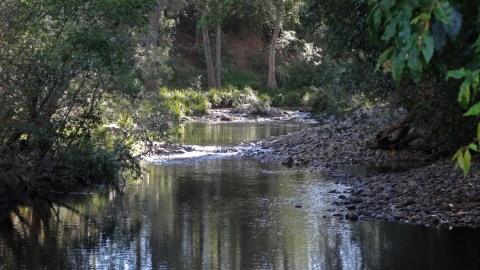- Home
- Assessments
- Bioregional Assessment Program
- Methods
- Propagating uncertainty through models
Executive summary
The surface water and groundwater modelling provides key information for bioregional assessments (BAs), including estimates of the future hydrological regime within the subregion or bioregion, and, in particular, those aspects of the regime subject to hydrological changes due to coal resource development. The robust and comprehensive characterisation of the uncertainty in those models is critical to BA as it underpins the assessment of risk and the likelihood that specific hydrological changes or impacts might occur.
This submethodology gives an overview of the uncertainty analysis and general methods for its implementation in a BA, noting that they may need to be customised for each specific BA. While highlighting linkages with other BA products and submethodologies, this submethodology focuses on the propagation of uncertainty through the chain of numerical models to assess the impact of coal resource development on water and water-dependent assets. The receptor impact modelling submethodology M08 (as listed in Table 1) characterises uncertainty in the system’s responses to those hydrological changes.
At the core of this submethodology is the structured characterisation of uncertainty through probability distribution functions, based on measurement data or from expert elicitation. This concentrates in particular on model parameter uncertainty (e.g. hydraulic conductivities of individual model layers or recharge rates) but might also examine other important assumptions such as the presence of unknown subsurface faults or water management rules as appropriate to specific subregions or bioregions. Any aspect of the model that cannot be included in the formal uncertainty analysis (such as discrete choices and model assumptions) will not only be documented, but will also be submitted to a pedigree analysis to assess the quality of the model choice and the potential impact on the prediction. The pivotal aspect of a pedigree analysis is the analysis of the implications and influence of the model assumptions. The main benefit is that it provides a structured way of thinking about and analysing model assumptions which can help in the open and transparent communication of model uncertainty.
This submethodology is structured around a compartmentalisation of the model chain followed by a comprehensive sensitivity analysis to identify the factors that most influence the model prediction of specific hydrological response variables at receptor locations. The subset of factors the prediction is sensitive to will subsequently be used in the uncertainty analysis which propagates the uncertainty in the input factors to the prediction using a Monte Carlo approach. In the event that relevant observational data are available, these will be integrated in the process to constrain the probability distribution of the prediction. In order to keep the computational load manageable and the submethodology amenable to automation, the uncertainty analysis will be carried out with model emulators. The resulting probability distribution functions of the impacts on the hydrological response variables will provide a starting point for the receptor impact modelling.
Examples of the outputs of the sensitivity and uncertainty analysis are included in submethodologies M06 and M07 (as listed in Table 1). Results from the uncertainty analysis are reported in 2.6.1 (surface water numerical modelling) and product 2.6.2 (groundwater numerical modelling) for each Assessment.

